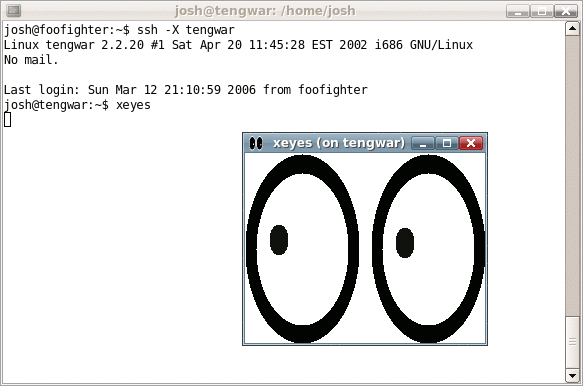|
X Image Extension
X Image Extension, or XIE was an extension to the X Window System to enhance its graphics capability. It was intended to provide a powerful mechanism for the transfer and display of virtually any image on any X-capable hardware. It was first released with X11R6 in 1994. It is no longer included in the X11 reference distribution, having been removed with X11R6.7 in 2004. XIE never gained significant usage — according to Jim Gettys, ''"it failed due to excessive complexity and lack of a good implementation."'' While not intended for use as a general-purpose image-processing engine, XIE did provide a set of image rendition and enhancement primitives that could be combined into arbitrarily complex expressions. XIE also provided import and export facilities for moving images between client and server, and for accessing images as resources. The client side programming library, XIElib, was documented in the Prentice Hall book ''Developing Imaging Applications with XIElib'' by Syd L ... [...More Info...] [...Related Items...] OR: [Wikipedia] [Google] [Baidu] [Amazon] |
X Window System
The X Window System (X11, or simply X) is a windowing system for bitmap displays, common on Unix-like operating systems. X originated as part of Project Athena at Massachusetts Institute of Technology (MIT) in 1984. The X protocol has been at version 11 (hence "X11") since September 1987. The X.Org Foundation leads the X project, with the current reference implementation, X.Org Server, available as free and open-source software under the MIT License and similar permissive licenses. Purpose and abilities X is an architecture-independent system for remote graphical user interfaces and input device capabilities. Each person using a networked computer terminal, terminal has the ability to interact with the display with any type of user input device. In its standard distribution it is a complete, albeit simple, display and interface solution which delivers a standard widget toolkit, toolkit and protocol stack for building graphical user interfaces on most Unix-like operating syst ... [...More Info...] [...Related Items...] OR: [Wikipedia] [Google] [Baidu] [Amazon] |
Computer Graphics
Computer graphics deals with generating images and art with the aid of computers. Computer graphics is a core technology in digital photography, film, video games, digital art, cell phone and computer displays, and many specialized applications. A great deal of specialized hardware and software has been developed, with the displays of most devices being driven by graphics hardware, computer graphics hardware. It is a vast and recently developed area of computer science. The phrase was coined in 1960 by computer graphics researchers Verne Hudson and William Fetter of Boeing. It is often abbreviated as CG, or typically in the context of film as Computer-generated imagery, computer generated imagery (CGI). The non-artistic aspects of computer graphics are the subject of Computer graphics (computer science), computer science research. Some topics in computer graphics include user interface design, Sprite (computer graphics), sprite graphics, raster graphics, Rendering (computer graph ... [...More Info...] [...Related Items...] OR: [Wikipedia] [Google] [Baidu] [Amazon] |
Jim Gettys
Jim Gettys (born 15 October 1953) is an American computer programmer. Activity Gettys worked at Digital Equipment Corporation, DEC's Cambridge Research Laboratory. He is one of the original developers of the X Window System at MIT and worked on it again with X.Org Server, X.Org, where he served on the board of directors. Until January 2009, he was the Vice President of Software at the One Laptop per Child project, working on the software for the OLPC XO-1. From 2009 through 2014, he worked at Alcatel-Lucent Bell Labs. Gettys was the co-founder of the group investigating bufferbloat and the effect it has on the performance of the Internet. He was a core member of the group from 2010 to 2017, concluding with his publication of "The Blind Man and the Elephant", calling for the wide adoption of fair queuing and active queue management techniques across the Internet, particularly RFC8290. He served on the GNOME foundation board of directors. He worked at the World Wide Web Con ... [...More Info...] [...Related Items...] OR: [Wikipedia] [Google] [Baidu] [Amazon] |
Import
An importer is the receiving country in an export from the sending country. Importation and exportation are the defining financial transactions of international trade. Import is part of the International Trade which involves buying and receiving of goods or services produced in another country. The seller of such goods and services is called an exporter, while the foreign buyer is known as an importer. In international trade, the importation and exportation of goods are limited by import quotas and mandates from the customs authority. The importing and exporting jurisdictions may impose a tariff (tax) on the goods. In addition, the importation and exportation of goods are subject to trade agreements between the importing and exporting jurisdictions. Definition Imports consist of transactions in goods and services to a resident of a jurisdiction (such as a nation) from non-residents. The exact definition of imports in national accounts includes and excludes specific "borderlin ... [...More Info...] [...Related Items...] OR: [Wikipedia] [Google] [Baidu] [Amazon] |
Export
An export in international trade is a good produced in one country that is sold into another country or a service provided in one country for a national or resident of another country. The seller of such goods or the service provider is an ''exporter''; the foreign buyer is an '' importer''. Services that figure in international trade include financial, accounting and other professional services, tourism, education as well as intellectual property rights. Exportation of goods often requires the involvement of customs authorities. Firms For any firm, Global expansion strategies may include: * Franchising, * Turn Key Project, * Export, * Joint Venture, * Licensing, * Creating an owned subsidiary, * Acquisition, * Merger, etc. Exporting is mostly a strategy used by product based companies. Many manufacturing firms begin their global expansion as exporters and only later switch to another mode for serving a foreign market. Barriers There are four main types of expo ... [...More Info...] [...Related Items...] OR: [Wikipedia] [Google] [Baidu] [Amazon] |
X Consortium
The X Window System (X11, or simply X) is a windowing system for bitmap displays, common on Unix-like operating systems. X originated as part of Project Athena at Massachusetts Institute of Technology (MIT) in 1984. The X protocol has been at version 11 (hence "X11") since September 1987. The X.Org Foundation leads the X project, with the current reference implementation, X.Org Server, available as free and open-source software under the MIT License and similar permissive licenses. Purpose and abilities X is an architecture-independent system for remote graphical user interfaces and input device capabilities. Each person using a networked terminal has the ability to interact with the display with any type of user input device. In its standard distribution it is a complete, albeit simple, display and interface solution which delivers a standard toolkit and protocol stack for building graphical user interfaces on most Unix-like operating systems and OpenVMS, and has bee ... [...More Info...] [...Related Items...] OR: [Wikipedia] [Google] [Baidu] [Amazon] |
MIT-SHM
The MIT Shared Memory Extension or MIT-SHM or XShm is an X Window System extension for exchange of image data between client and server using shared memory (usually ). The mechanism only works when both pieces are on the same computer. The basic capability provided is that of shared memory XImages. This is essentially a version of the ximage interface where the actual image data is stored in a SysV shared memory segment, and thus need not be transferred across the socket to the X server. For large images, use of this facility can result in some real performance increases. Additionally, some implementations provide shared memory pixmaps. These are two-dimensional arrays of pixels in a format specified by the X server, where the image data is stored in the shared memory segment. Through use of shared memory pixmaps, it is possible to change the contents of these pixmaps without using any Xlib Xlib (also known as libX11) is an X Window System protocol client library (compu ... [...More Info...] [...Related Items...] OR: [Wikipedia] [Google] [Baidu] [Amazon] |
The Open Group
The Open Group is a global consortium that seeks to "enable the achievement of business objectives" by developing " open, vendor-neutral technology standards and certifications." It has 900+ member organizations and provides a number of services, including strategy, management, innovation and research, standards, certification, and test development. It was established in 1996 when X/Open merged with the Open Software Foundation. The Open Group is the certifying body for the UNIX trademark, and publishes the Single UNIX Specification technical standard, which extends the POSIX standards. The Open Group also develops and manages the TOGAF standard, which is an industry standard enterprise architecture framework. Members The 900+ members include a range of technology vendors and buyers as well as government agencies, including, for example, Capgemini, Fujitsu, Hewlett Packard Enterprise, Orbus Software, IBM, Huawei, the United States Department of Defense and NASA. There is ... [...More Info...] [...Related Items...] OR: [Wikipedia] [Google] [Baidu] [Amazon] |
POSIX
The Portable Operating System Interface (POSIX; ) is a family of standards specified by the IEEE Computer Society for maintaining compatibility between operating systems. POSIX defines application programming interfaces (APIs), along with command line shells and utility interfaces, for software compatibility (portability) with variants of Unix and other operating systems. POSIX is also a trademark of the IEEE. POSIX is intended to be used by both application and system developers. As of POSIX 2024, the standard is aligned with the C17 language standard. Name Originally, the name "POSIX" referred to IEEE Std 1003.1-1988, released in 1988. The family of POSIX standards is formally designated as IEEE 1003 and the ISO/IEC standard number is ISO/ IEC 9945. The standards emerged from a project that began in 1984 building on work from related activity in the ''/usr/group'' association. Richard Stallman suggested the name ''POSIX'' to the IEEE instead of the former ''IEEE-IX''. Th ... [...More Info...] [...Related Items...] OR: [Wikipedia] [Google] [Baidu] [Amazon] |
X/Open Portability Guide
X/Open group (also known as the Open Group for Unix Systems and incorporated in 1987 as X/Open Company, Ltd.) was a consortium founded by several European UNIX systems manufacturers in 1984 to identify and promote open standards in the field of information technology. More specifically, the original aim was to define a single specification for operating systems derived from UNIX, to increase the interoperability of applications and reduce the cost of porting software. Its original members were Bull, ICL, Siemens, Olivetti, and Nixdorf—a group sometimes referred to as BISON. Philips and Ericsson joined in 1985, at which point the name X/Open was adopted. The group published its specifications as X/Open Portability Guide, starting with Issue 1 in 1985, and later as ''X/Open CAE Specification''. In 1987, X/Open was incorporated as X/Open Company, Ltd. By March 1988, X/Open grew to 13 members: AT&T, Digital, Hewlett-Packard, Sun Microsystems, Unisys, NCR, Olivetti, Bull, Ericsson ... [...More Info...] [...Related Items...] OR: [Wikipedia] [Google] [Baidu] [Amazon] |
X Window Extensions
X, or x, is the twenty-fourth Letter (alphabet), letter of the Latin alphabet, used in the English alphabet, modern English alphabet, the alphabets of other western European languages and others worldwide. Its name in English is Wikt:ex#English, ''ex'' (pronounced ), plural ''exes''."X", ''Oxford English Dictionary'', 2nd edition (1989); ''Merriam-Webster's Third New International Dictionary of the English Language, Unabridged'' (1993); "ex", ''op. cit''. History The letter , representing , was inherited from the Etruscan alphabet. It perhaps originated in the of the Archaic Greek alphabets#Euboean, Euboean alphabet or another Western Greek alphabet, which also represented . Its relationship with the of the Eastern Greek alphabets, which represented , is uncertain. The pronunciation of in the Romance languages underwent Palatalization in the Romance languages, sound changes, with various outcomes: * French language, French: (e.g. ''laisser'' from ''laxare'') * Itali ... [...More Info...] [...Related Items...] OR: [Wikipedia] [Google] [Baidu] [Amazon] |



